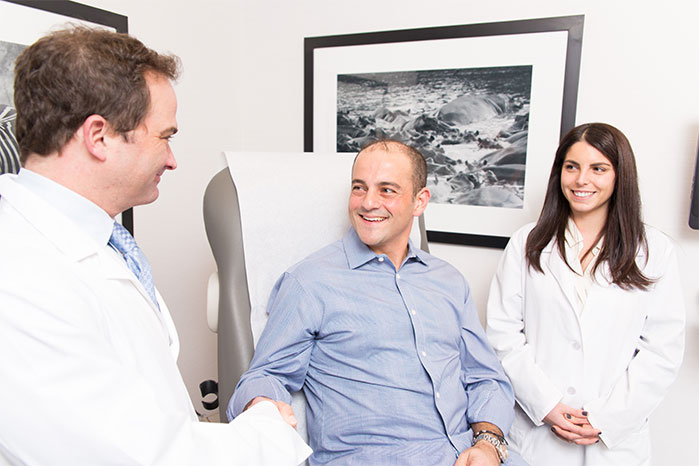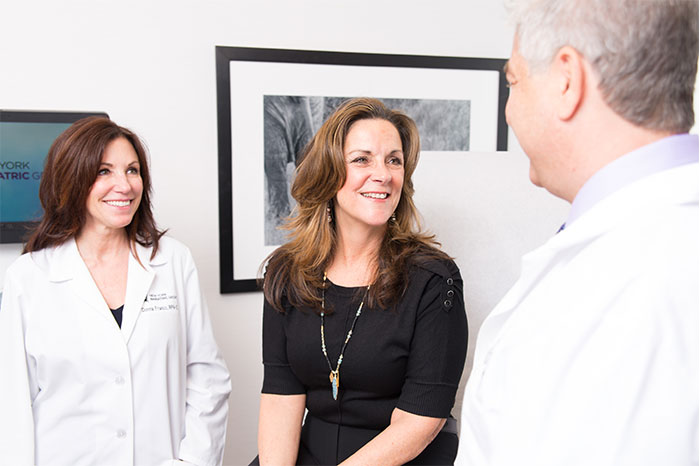From our initial consultation to our post-treatment care, years of experience has lead us to our current position as a leader in reflux surgery. Today we have grown to be a team of experienced, trusted and innovative surgeons who guide scores of patients to a discomfort and pain-free life, free of acid reflux. Find out what you can do to achieve a life free from GERD.
REFLUX INFORMATION

Risks of Reflux
The stomach contents are damaging to the esophagus. With repeated insults, these contents damage the lining of the esophagus which can lead to erosions, esophageal ulcers, bleeding, and inflammation known as esophagitis.
Over time esophagitis and repeated inflammation will lead to scarring which can cause stricture formation and can damage the muscular components of the esophagus. This can weaken the esophagus predisposing it to further injury.
Repeated damage can also lead to the development of Barrett’s esophagus where the lining of the esophagus changes to accommodate the repeated injury.
With continued damage, Barrett’s esophagus can transform into esophageal cancer. Esophageal cancer is dangerous and has an especially high 5-year mortality compared to other malignancies.
Repeated exposure to heartburn can also lead to a breakdown of enamel, the hard outer layer covering your teeth. This can lead to cavities and other forms of tooth decay.
FAQs
How common is GERD?
Gastroesophageal reflux disease is quite common. Up to 20% of individuals in Western countries experience symptoms of GERD. Some of these symptoms may be controlled by medication but if severe or long-lasting, you should consult your physician to explore other treatment options.
How does a hiatal hernia develop?
The development of a hiatal hernia is poorly understood. A number of risk factors contribute including obesity, age, and pregnancy. It is thought that increased pressure in the abdomen may have a role in its formation which can occur as a result of straining, coughing, vomiting, or sudden physical exertion.
What is the role of hiatal hernia in GERD? A hiatal hernia exists when the top portion of the stomach rests in the chest due to a larger than normal opening in the diaphragm where the esophagus typically enters. The lower pressures present in the chest lead to a higher rate of LES dysmotility with stomach contents passing more easily into the esophagus.
What are the chances I will develop Barrett’s esophagus if I have GERD?
Barrett’s esophagus has been shown to develop in approximately 10-20% of patients with chronic GERD or inflammation of the esophagus. Barrett’s tends to occur more often in men than women and more often in Caucasian Americans than African Americans. The average age is 55 years at diagnosis.

SCHEDULE TODAY!
Schedule a consultation today and free yourself from acid reflux. You have goals, we can get you there.
Types of Reflux
Barrett’s Esophagus
Barrett’s esophagus is an abnormal change in the lining of the esophagus occurring most commonly at the gastroesophageal junction. This entity develops from repeated exposure of the esophagus to acid. Approximately 10-20% of patients with chronic GERD or inflammation of the esophagus will develop Barrett’s. Barrett’s tends to occur more often in men than women and more often in Caucasian Americans than African Americans. The average age is 55 years at diagnosis. This is a premalignant condition and highly associated with further transformation to esophageal cancer.
Hiatal Hernia
A hiatal hernia is a type of hernia involving the diaphragm and often related to acid reflux. Through this hernia, abdominal organs, most commonly the stomach, can slip through the diaphragm into the chest cavity.
A number of symptoms can develop from this not limited to heartburn and esophageal reflux. Other symptoms may include difficulty swallowing and chest pain. Complications can include anemia, volvulus(twisting of our anatomical organs), or bowel obstruction.
Two main types of hiatal hernia exist: a sliding hiatal hernia where the body of the stomach moves through the diaphragm along with the ge junction and a paraesophageal hernia where the stomach or another organ moves through the diaphragm alongside the esophagus.
GERD
Gastroesophageal reflux system is a chronic disorder of the lower esophageal sphincter(LES). This sphincter is a circular band of muscle separating the esophagus from the stomach. Its function is to prevent the backup of stomach contents into the esophagus. A decrease in tone of this sphincter leads to the reflux of gastric contents including acid and bile that may damage the esophagus and lead to inflammation and injury. Over time, this injury will become cumulative and lead to greater esophageal dysfunction.
An estimated 20 percent of people in the United States suffer from symptoms of GERD. Our group has a large experience of treating and helping individuals that suffer from GERD.
Symptoms:
The most common symptom of GERD is heartburn. This is experienced as a burning chest pain beginning behind the sternum that can move upward towards the throat. This can often occur with regurgitation. Some people may report a bitter or acidic taste coming into their throat or the back of their mouth. These symptoms can last for several hours and are typically worse after eating.
Some individuals may experience difficulty swallowing as a result of stricture formation due to the repeated esophageal injury that takes place. Other symptoms of GERD can include cough, sore throat, a hoarseness, change in voice quality, asthma, and a feeling of a lump or a ball present in the throat known as globus.

Treatment Types
Mild GERD can often be controlled with lifestyle changes. Some of these include:
- Weight loss
- Elevating the head of the bed
- Not eating 3-4 hours before you sleep
- Not laying down after meals
- Avoiding common diet elements that trigger GERD. Common trigger foods include foods that are high in fat, citrus fruits and tomatoes, chocolate, spicy foods and foods with garlic and onions, caffeine, mint
- Wearing loose clothing that will not constrict the abdomen
Medical Treatments
Antacids – These medications neutralize the acidity present from GERD and should be primarily used for symptomatic relief. Examples include Tums, Maalox, Mylanta, Pepto-Bismol, and Alka-Seltzer.
Histamine-2 blockers – These medications limit the amount of acid that is produced which will in turn cause a decrease in the amount of acid that can reflux into the esophagus. These are most effective when taken regularly on a daily basis as prescribed by your physician. Examples include Pepcid(famotidine), Zantac(ranitidine), Axid(nizatidine) and Tagamet(cimetidine).
Proton pump inhibitors (PPIs) – These medications also work by limiting the amount of acid that is produced. They act directly on the pump in the cells of the stomach lining that secrete acid. These are the most potent medications and most effective at eliminating symptoms and healing esophageal injury. These medications can have more adverse effects. Examples include Prilosec(omeprazole), Protonix(pantoprazole), Prevacid(lansoprazole), and Nexium(esomeprazole).
More severe forms of GERD are best treated with surgery. A number of specific indications for procedural or surgical therapy exist and include:
- Failure of medical management
- Need for long-term medical therapy
- Complications of GERD – E.g. Barrett’s esophagus
- Patient preference
- Extraesophageal manifestations such as asthma, hoarseness, aspiration
- Mixed hiatal and paraesophageal hernia with coincided reflux
- Recurrent reflux after previous therapy
Preoperative evaluation
We complete a thorough preoperative evaluation to ensure you receive the procedure that will match your needs and guide you to a successful recovery.
Testing you will most often include an endoscopy, manometry(or motility) study, and a pH monitoring study.
Our Process
If you are ready to get help for your acid reflux and recover a discomfort or pain-free lifestyle, you have many options at our New York Reflux Group. One of the reasons so many patients choose us is that we combine surgical expertise with competent care, compassion, and the understanding to lead you through the journey to a reflux-free life. Convenient locations serve patients in Manhattan, Smithtown, Stamford, Port Jefferson, Fishkill, Astoria and more!
